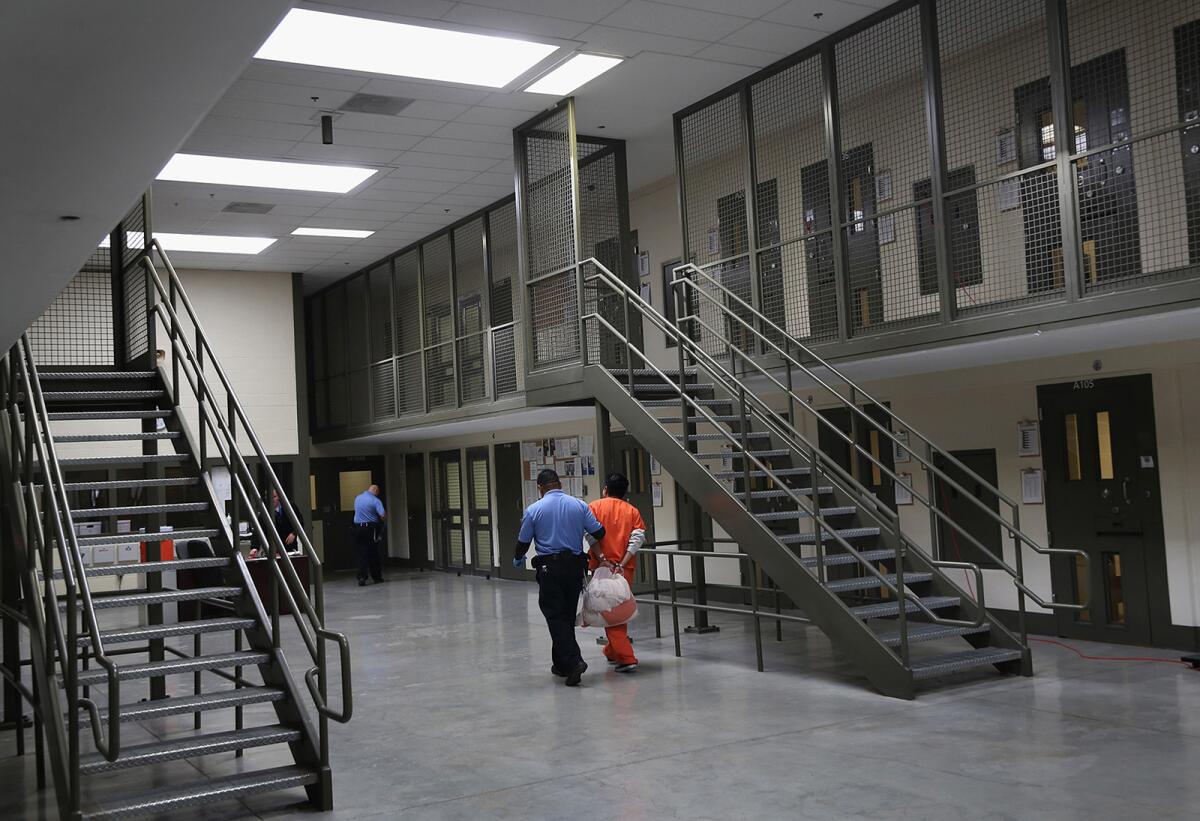Private inspectors paint a rosy picture of U.S. immigrant detention centers. Audits find otherwise

JEFFERSON, Md. — For the past year, the tiny Maryland company employed by the federal government to inspect U.S. immigration detention centers has painted a rosy picture of life in captivity.
In dozens of reports filed in the past 12 months, inspectors with the 11-person Nakamoto Group described detainees who had “no substantive complaints” and facilities where the atmosphere is “calm with no obvious indicators of high stress.”
“None of the detainees expressed any concerns about their treatment or safety,” Nakamoto employees wrote in a typical March 2019 report, following inspection of the Rio Grande Detention Center in Laredo, Texas, a border city overwhelmed by recent waves of Central American migrants seeking asylum.
“Detainees were satisfied with all conditions of their confinement.”
Nakamoto’s bland assessments — some of which date back more than a decade — stand in stark contrast to recent findings by the Department of Homeland Security’s inspector general, state auditors and outside watchdog groups, which have documented lax medical and mental health care and inappropriate use of solitary confinement at multiple U.S. Immigration and Customs Enforcement agency facilities.
A review by Kaiser Health News of thousands of pages of inspection reports from 2007 to 2012, and 2017 to 2019 — made available through litigation and new federal reporting requirements — reveals disturbing patterns about the company’s audits, including a general willingness to accept the accounts of the facilities that the company is paid to scrutinize, and to discount detainees’ complaints.
The findings show that Nakamoto has rarely reported bad news about conditions at the for-profit and government-run facilities it audits. Violations in the quality of medical care and safety of detainees are infrequent and cursory, according to a review of federal records and court documents.
For example, a surprise May 2018 inspection by government investigators at the Adelanto ICE Processing Facility in California’s Mojave Desert “revealed significant health and safety risks,” “improper and overly restrictive segregation” and “inadequate detainee medical care,” according to the Homeland Security agency’s inspector general. A separate 2019 investigation by Disability Rights California, a nonprofit group with legal authority to monitor detention centers in California, highlighted people with serious mental illness being doused with pepper spray and multiple unreported suicide attempts.
Yet Nakamoto drew a very different conclusion in its 2018 report on Adelanto: While it noted hundreds of grievances from detainees and 83 physical assaults during the inspection period — more than one-third of which resulted in injuries that required medical referrals — its report concluded that “without exception, detainees stated that they felt safe at this facility.”
A June report by the inspector general found “unsafe and unhealthy conditions” at three other detention centers as well. All four had been given passing grades by Nakamoto.
Several current and former Adelanto detainees interviewed said delays in medical care were frequent and fear was pervasive inside the remote facility. Among the concerns, they said, was the sense that guards would indiscriminately send detainees to solitary confinement, known as “the Hole,” for the slightest infraction.
“It didn’t matter if you were good or if you were bad, you were always going to be put in the Hole,” said Lillian, 49, a former human rights professor from Caracas, Venezuela, who asked not to be identified by her last name for fear of reprisal. She was held at Adelanto from November 2017 until she was granted asylum in May 2018.
Other detainees said delays in medical care were so common at Adelanto that many people stopped filing requests. “You put in a medical request, and it can take days or weeks or even months for them to process it and give you the treatment you need,” said Mario, 32, who crossed into the U.S. with his parents when he was 5 and was held at Adelanto for six months in 2018.
Facing deportation for a 2017 misdemeanor, Mario is now out on bond and volunteering with an immigrant rights group in Ontario, Calif. He also asked not to be identified by his last name, for fear it would affect his deportation case.
The Nakamoto Group was established in 2003 by Jennifer Nakamoto, then in her 30s and a former employee at the National Institute on Drug Abuse. She remains the company’s president and sole owner. The George W. Bush administration first hired the company to audit immigration detention facilities, and its contracts were extended under President Obama.
For at least the last two years, the Nakamoto Group — registered to Jennifer Nakamoto’s spacious home in the rolling farmland of western Maryland — has been the sole contractor responsible for inspecting nearly 100 federal immigration detention centers and county jails that house tens of thousands of noncitizens awaiting deportation hearings or decisions on pleas for asylum.
Since 2007, ICE has awarded the company more than $55 million in government contracts to ensure conditions meet federal detention standards. Its current contract could fetch another $16 million.
Nakamoto continues as the sole contracted inspector at ICE facilities even though John Kelly, Homeland Security’s former acting inspector general, issued a blistering analysis of its performance last year.
“Nakamoto’s inspection practices are not consistently thorough, its inspections do not fully examine actual conditions or identify all compliance deficiencies,” he wrote.
Kelly’s report noted that ICE employees told federal investigators that Nakamoto’s inspections are “useless” and “very, very, very difficult to fail.”
Mark Saunders, executive vice president for the Nakamoto Group, declined to discuss the company’s performance in detail. In an interview, he said only that he refuted the accusations in the inspector general’s report, and that the company “is the only impartial party.” He would not comment further.
ICE officials did not respond to specific requests for comment about Nakamoto’s contract.
A ‘rubber stamp’?
Questions about Nakamoto’s oversight come as the federal government struggles to process an unprecedented influx of migrants fleeing poverty and violence in Central America.
With the detainee population surging to 53,000 people this year, immigrant rights organizations contend that ICE is under pressure to keep facilities open at any cost — and that the agency has insulated itself from reproach by hiring inspectors who act as allies for the private prison companies that now house the majority of U.S. detainees.
(The children’s migrant detention centers that have been the topic of recent news reports and congressional visits are run by the U.S. Customs and Border Protection agency and subject to a different oversight process.)
“Nakamoto has this incentive to not be as critical as they could be” to maintain its lucrative government contract, said Aaron Fischer, an attorney with Disability Rights California.
Eunice Cho, a staff attorney at the ACLU of Washington, called Nakamoto inspections a “rubber stamp.”
Concerns over conditions in detention facilities stretch back decades and led to a change in policy during the Obama administration. A 2010 law barred facilities that failed two consecutive inspections from being paid.
The change was meant to weed out poorly managed programs. Instead, in subsequent years, inspectors have been less likely to fail facilities. Private inspectors failed nearly three dozen facilities from 2007 to 2009, and at least 14 facilities received poor reviews two years in a row.
But from 2010 to 2012, only one facility — the Freeborn County Adult Detention Center in Minnesota — failed an inspection. Since May 2018, only one facility appears to have failed.
The Adelanto facility failed an inspection in 2011 conducted by a different private contractor, MGT of America — only to have ICE overturn the finding. The following year, ICE hired Nakamoto to audit Adelanto and, despite the death of a 58-year-old detainee, the facility passed. Federal authorities who later investigated concluded that Adelanto had committed “egregious errors,” including failing to provide timely medical care, and could have prevented the death.
Nakamoto announces inspections in advance and relies on the facilities’ records to track grievances, assaults and other measures. Some inspection reports go into detailed descriptions of trivial mishaps: tepid chicken patties or improperly inventoried tools and kitchen chemicals.
But its inspectors are frequently derisive of more serious complaints, dismissing medical and safety concerns. In a January inspection of the Otero County Processing Center, a 1,000-bed detention facility in Chaparral, N.M., Nakamoto inspectors noted and wrote off complaints about lukewarm showers (“water temperatures were checked and were within the parameters”) and requests for food items from detainees (“they were all from countries that partake in non-traditional foods that are most likely not approved for consumption in the United States”).
They concluded that, “without exception, detainees stated that they felt safe at the facility,” which is operated by the Management and Training Corp.
In fact, asylum-seekers at Otero had voiced grave concerns about conditions and long waits in detention, going so far as to stage nearly 100 hunger strikes last year.
While Nakamoto inspectors noted the hunger strikes, they accepted the facility’s explanation that they were being staged by “certain nationalities” who “apparently believe that they should be catered to at a higher rate of service than other detainees.”
A death in detention
Similarly, in dozens of audits at different facilities, Nakamoto inspectors methodically refuted complaints about medical care based largely on records that immigration attorneys say are often inaccurate or incomplete.
A detainee held in Versailles, Mo., for instance, told a Nakamoto inspector in February that he needed glasses. Nakamoto accepted the facility’s determination that he did not and suggested instead that a lack of natural light might be contributing to his poor vision.
At Webb County Detention Center in Laredo, Texas, a woman said she waited 15 days and made two requests to see a doctor. Again, Nakamoto accepted the facility’s determination: “The detainee was seen and treated in a timely manner.”
Cho, the ACLU attorney who is suing ICE, alleging detainee mistreatment, said, “There is a culture of not buying what detainees credibly have to say.”
When Kamyar Samimi, an Iranian national with permanent residency status, died in custody in December 2017, the divergence between Nakamoto’s assessment and that of federal investigators was striking.
Samimi, 64, had been arrested at his Denver home on Nov. 17, 2017, based on a 2005 drug conviction. Two weeks later, while detained at the ICE facility in Aurora, Colo., he vomited blood, stopped breathing and died 17 minutes after arriving at a nearby medical center.
In an inspection several months after Samimi’s death, Nakamoto inspectors reported he had been complaining of depression and withdrawal from methadone, a prescription drug he took daily to treat a long-dormant addiction. He had been placed on suicide watch, the company said, but no concerns about his medical treatment were found.
In its inquiry into the death, ICE’s Office of Professional Responsibility found that staff had failed to fully administer his medication and to seek emergency treatment in a timely manner.
When Sen. Elizabeth Warren of Massachusetts wrote Jennifer Nakamoto last November to express “deep concern” about the company’s work, Nakamoto said the inspector general didn’t understand the complexities of people held in prison-like centers.
In her written response, Nakamoto mockingly referred to government inspectors in quotation marks and questioned their qualifications. She described herself as “a hard-working minority woman, who took a risk 15 years ago in forming a small business to try to make my way in this great country.” She maintained her people are experts in their field and “staunch advocates of detainee rights.”
“Our work ethic is second to none,” she wrote. “We do not report inaccurately nor do we misrepresent information in our reports.”
Varney writes for Kaiser Health News, a nonprofit news service covering health issues. It is an editorially independent program of the Kaiser Family Foundation that is not affiliated with Kaiser Permanente.
More to Read
Sign up for Essential California
The most important California stories and recommendations in your inbox every morning.
You may occasionally receive promotional content from the Los Angeles Times.










